
Monplaisir is an ensemble - one of the parts (place) Lower Park of the Palace and Park Ensemble "Peterhof" in Peterhof (St. Petersburg).
The Monplaisir ensemble includes: the Monplaisir Palace, the Catherine Building and the Bath Building, which form small buildings in the shape of the letter "P" in the center of which is the Monplaisir Garden with fountains, flower beds and alleys.
In a broad sense, the entire complex, from the main building-the Monplaisir Palace, is called the Monplaisir Ensemble or the Monplaisir Ensemble.
The Monplaisir Ensemble is located on the shore of the Gulf of Finland, in the north-eastern part of the Lower Park The Grand Peterhof Palace. From the Palace of Montplaisir, the entire eastern part of the park is called Montplaisir.
In the walls of the Palace of Montplaisir, Catherine and Bath buildings today there are museums.
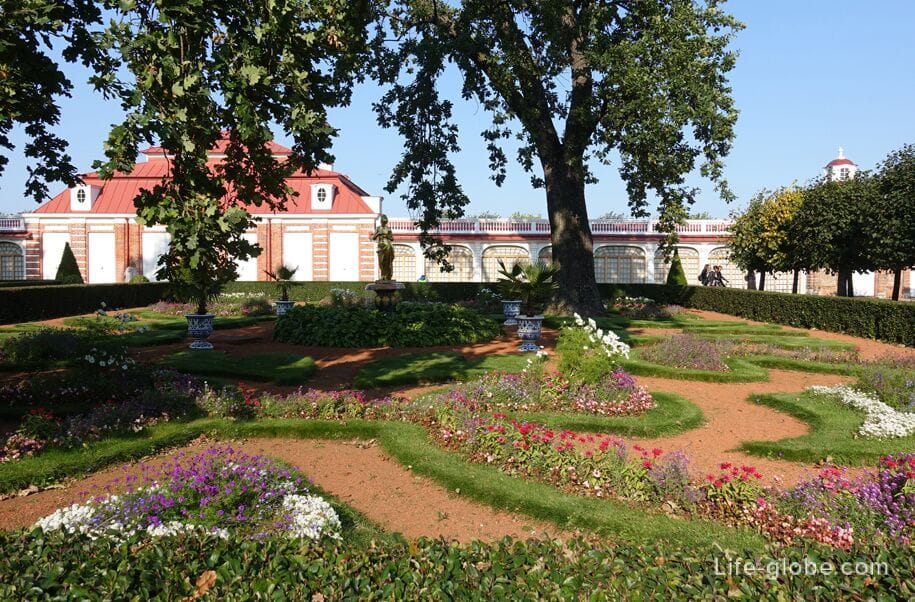


The Monplaisir Palace was built in 1714-1723 according to the plan, as well as the creation of the entire Grand Palace of Peterhof with parks, by Peter the Great. Peter the Great also personally made sketches, schematic drawings, the interior layout and some elements of the decorative decoration of the palace. The architects Andreas Schlueter, Johann Friedrich Braunstein, Jean-Baptiste Leblon and Nicolo Michetti brought the idea to life.
"Monplaisir "in French," monplaisir "means" my pleasure".
The decorative design of the palace was created under the influence of Dutch architecture of the 18th century, so this palace was sometimes called "Dutch House".
To the west and east of the main part of the palace diverge guest galleries.
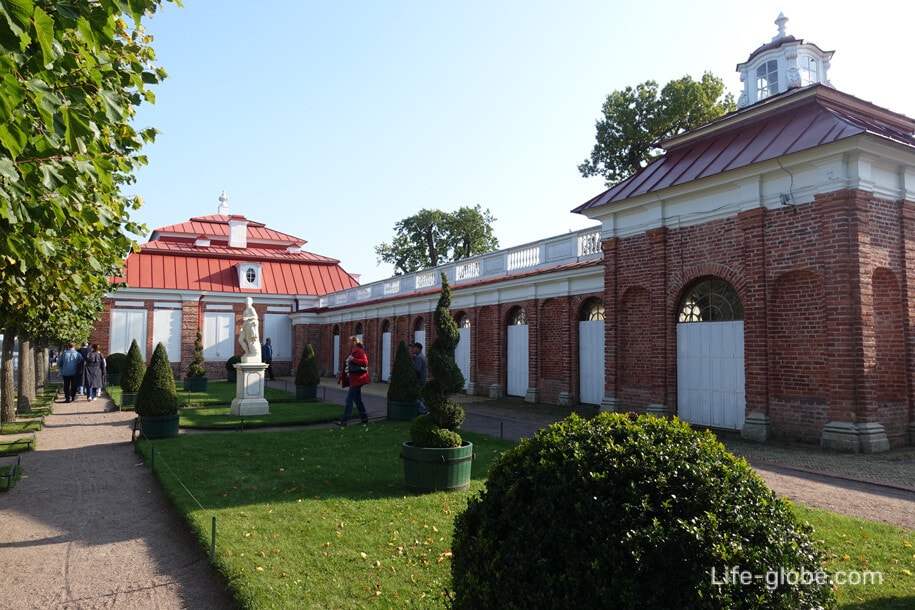
Today, the Palace of Montplaisir houses a museum.
The galleries and rooms of the palace are decorated with paintings of Western European paintings of the 17th and 18th centuries, most of which belong to the original collection collected by Peter I.
The grand hall, located in the center of the palace, is considered one of the achievements of the Peter the Great Baroque style. In the hall, special attention is drawn to the dome, in the sculptural and picturesque design of which there are themes of the changing seasons. The walls are finished in waxed oak, in the English style. In this hall, family holidays and victories of Russian weapons were celebrated, and receptions of foreign ambassadors were held. A large glass goblet, which can be seen on the table in the hall, is designed to remind of a serious punishment: the penalty "Big Eagle Cup", which during feasts was filled to the brim with wine and presented to violators of the rules imposed by the emperor.
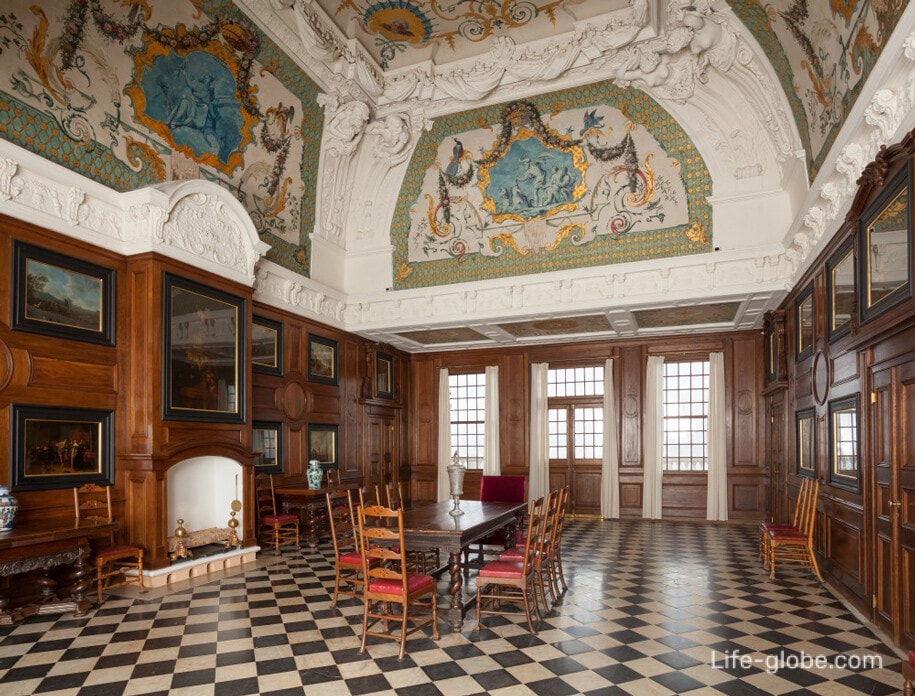

The walls of the palace's Lacquer Cabinet are decorated with large black-and-lacquer panels with miniature paintings made in the Chinese style. On the shelves-consoles attached between the panels, oriental porcelain is placed, which in the Peter the Great era was valued and was a source of pride. This cabinet, which has become a corner of the East in the walls of Montplaisir, was made specifically to accommodate a large collection of Chinese porcelain.
In the kitchen, decorated in the Dutch style, some dishes are displayed. A special feature of the Montplaisir cuisine is the presence of a stone sink for washing dishes, water for which was supplied through a pipe from the "Sheaf" fountain located in the Montplaisir Garden. The water supply and flush sewer system created for Montplaisir were innovations for the 18th century.
The study of Peter the Great is connected with the maritime theme. The lower part of the walls of the cabinet is decorated with tiles depicting 13 types of sailboats of that time. Navigation and measuring instruments, Navigation and measuring instruments are presented on the shelves of the cabinet.
Also in the museum are some preserved personal belongings of Peter the Great: a felt nightcap, a towel, a pitcher and a basin for washing.
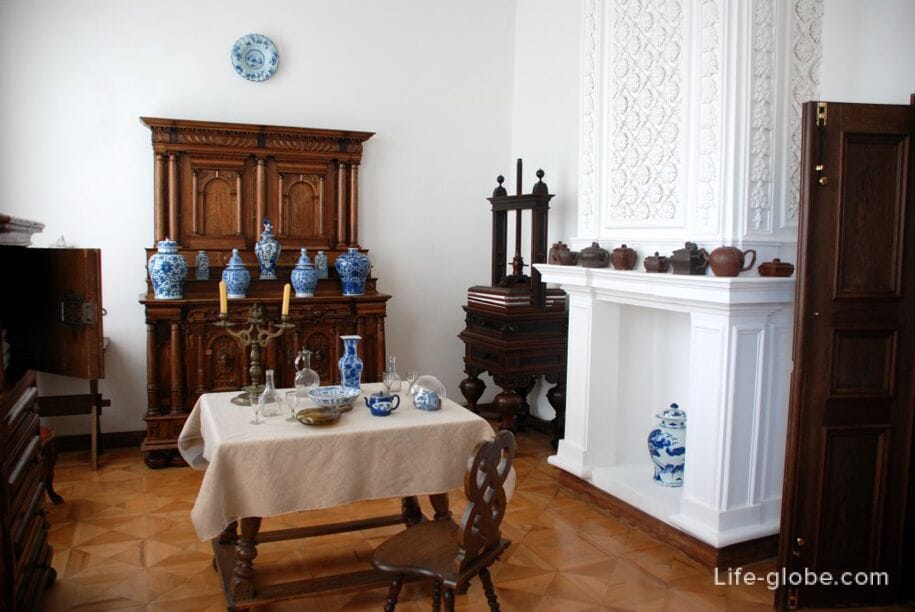

From the Gulf of Finland, an alley runs along the Monplaisir Palace. There is also an observation deck with views of the Gulf of Finland and three genre sculptures - Neptune, Amphitrite and Summer.
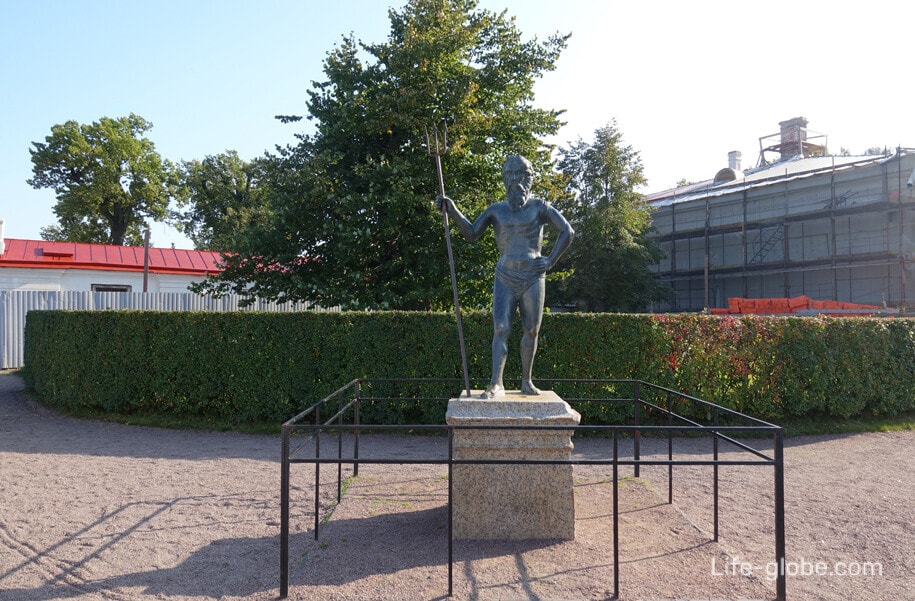

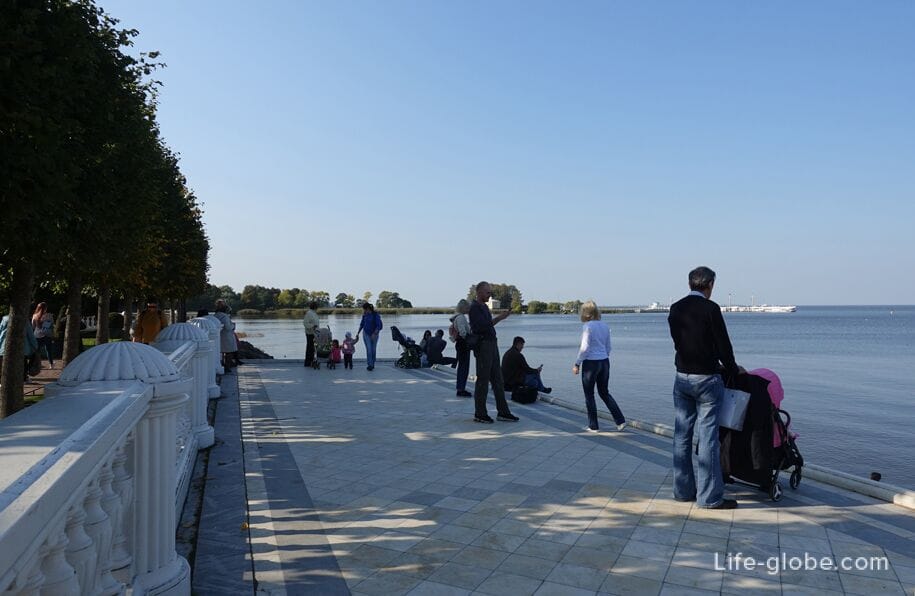

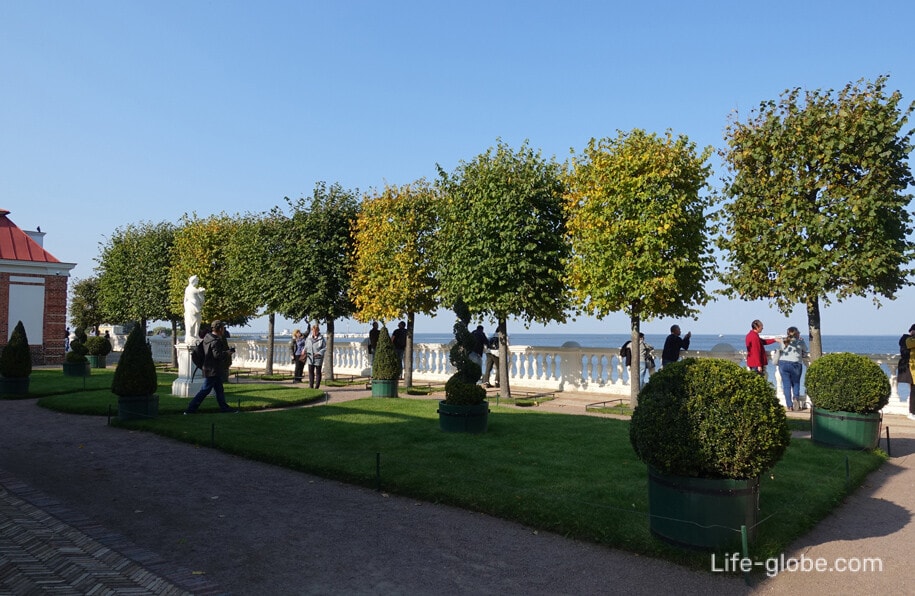
Adjacent to the west guest gallery of Montplaisir is the one-story Catherine's Building, built in 1747-1759 by the architect Francesco Rastrelli by decree of the Empress Elizabeth Petrovna (daughter of Peter I).
The palace was intended for holding court balls, receptions and banquets; and then it was called the "Stone Building".
The name "Catherine's Palace" was given to the palace in memory of the palace coup that elevated Catherine II to the throne. During the time of the Grand Duchess Catherine (when she was not yet an empress) she lived in the rooms of a wooden wing attached to the "Stone Building", from which on the morning of June 28, 1762, Catherine went to St. Petersburg to lead a plot to overthrow her husband, Emperor Peter III. This significant event in the history of Russia is recalled by the marble statue of Catherine II, located in the Lobby of the palace.
Upon her accession to the throne, Catherine II commissioned the architect Giacomo Quarenghi to re-design the Baroque interior decoration of the Catherine Building in the classical style. The new color of the walls determined the names of the palace rooms: Yellow Hall, Blue living room, Green Reception Room. The only room in the palace that has kept the Rastrelli decoration unchanged is the Reading Room.
The design of the palace continued in the time of Emperor Alexander I, when in 1817-1818 the walls and ceilings of some halls of the palace were decorated with Empire-style paintings made by Giovanni Batista Scotti.

Today, the Catherine Building is a museum.
The museum presents:
- collection of domestic furniture made of poplar, Karelian birch and mahogany. Empire-style furniture: a rook bed, bucket chairs, and a sofa with sphinx-shaped legs;
- collection of decorative bronze, including works of outstanding French masters: clocks, candelabra, candlesticks, incense burners, which were the decoration of the interior;
- tapestry "Peter I, rescuing fishermen during a storm on Lake Ladoga", woven at the famous Parisian manufactory. The tapestry was commissioned by Napoleon Bonaparte, completed under King Louis XVIII, who presented it to Emperor Alexander I.
In the study of Alexander I there are memorabilia related to the Patriotic War of 1812: a reduced copy of the marble obelisk installed on the Borodino field; a paperweight with authentic cores from the site of the Battle of Borodino; porcelain cups and glasses with portraits of war heroes; bas-reliefs on military themes and foreign campaigns of the Russian army; 1812.

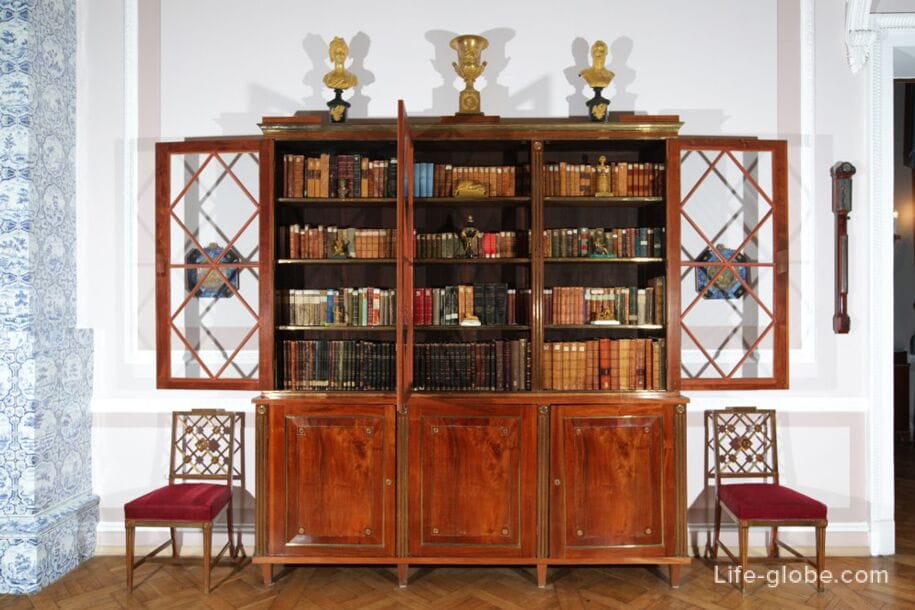
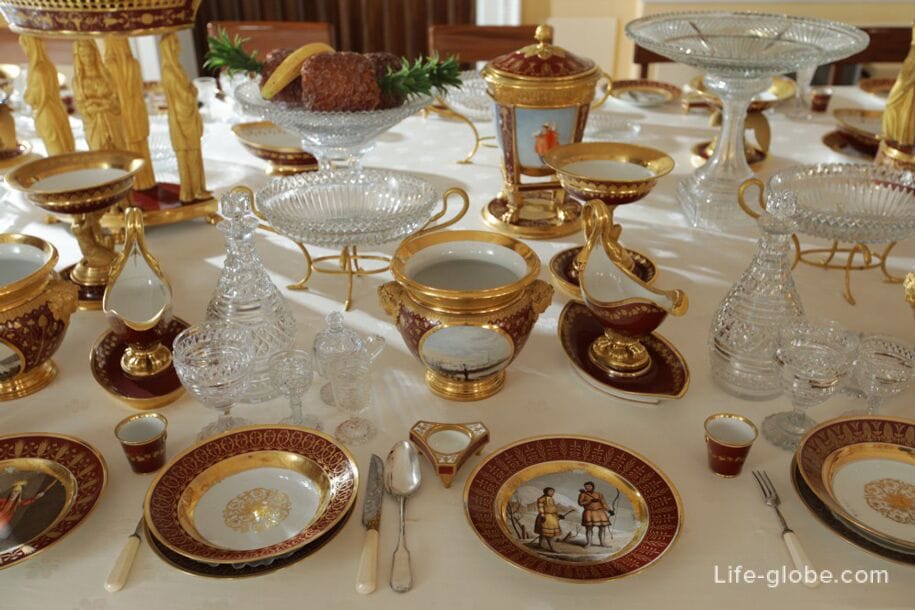
In the Yellow Hall, a ceremonial Guryev service made at the Imperial Porcelain Factory in St. Petersburg is presented.
The service consisted of about 5,000 items and was used only on special occasions. With its artistic design, the service celebrates Russia and its people - on the plates you can see dozens of images of the peoples of Russia, and on the wine refrigerators - views of St. Petersburg, Moscow and their surroundings.
The service is complemented by crystal, commissioned by Emperor Paul I in the late 18th century in England.
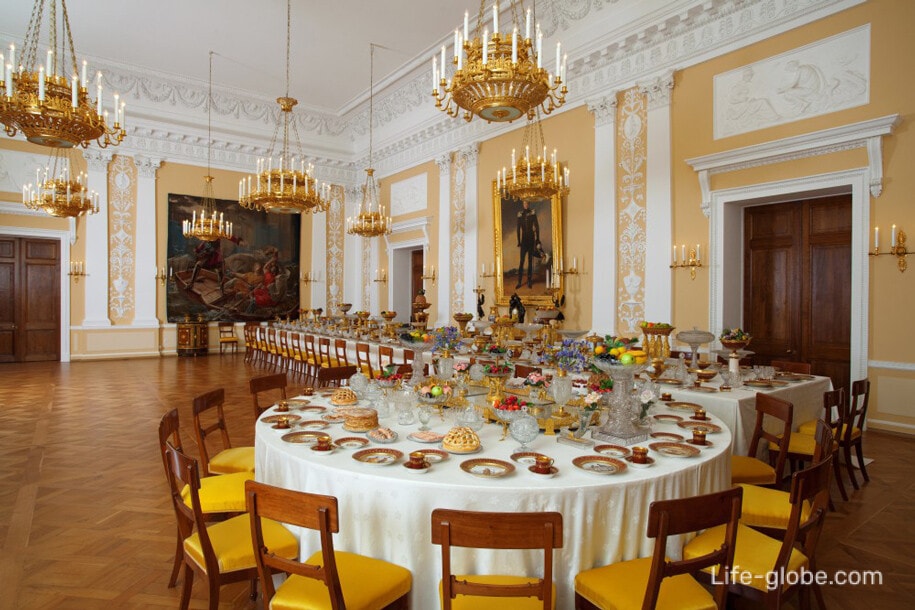
On the eastern side of the Monplaisir Palace is adjacent to the Bath Building, which is a complex of buildings for ceremonial and domestic purposes, built at different times.
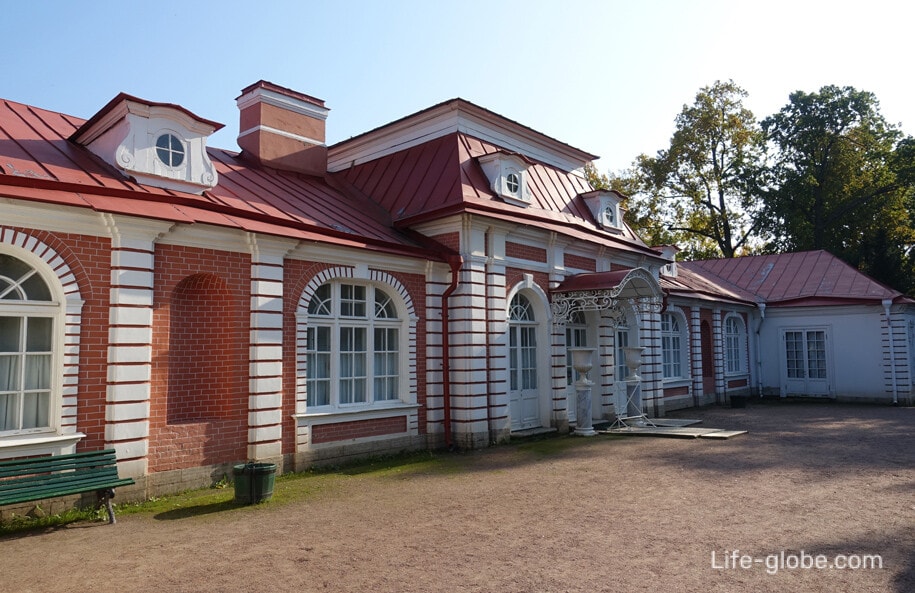
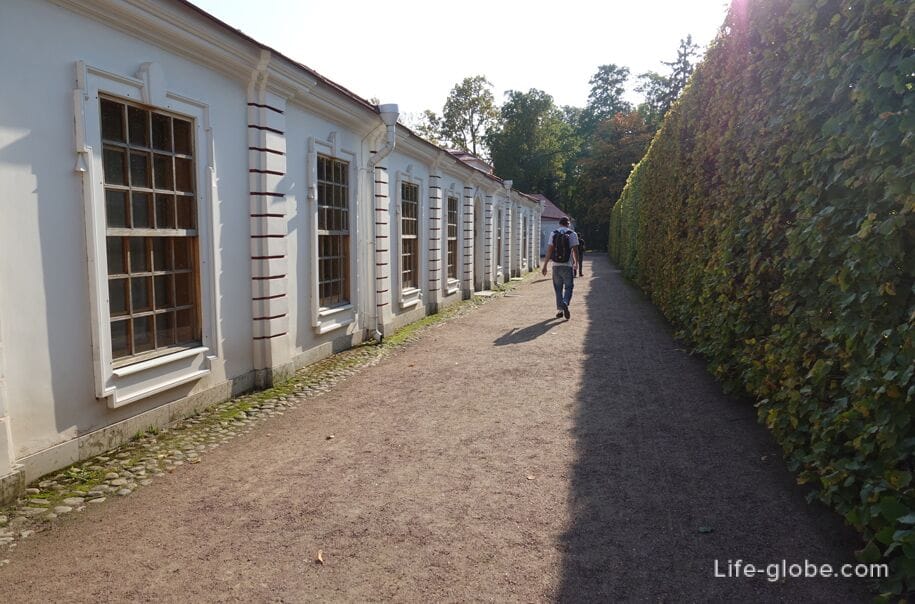
Today, within the walls of the building there is a museum, the exposition and interiors of which are inextricably linked with the history of the construction of the building.
The earliest building, dating back to Peter's time , is the Guest Chambers or "Chambers for the Family", adjacent to the building of the" Montplaisir " and which housed the relatives and confidants of the emperor.
Today, in the chambers, you can see one of the rooms intended for the royal guests, as well as get acquainted with Peter's special "Points about Peterhof" - the rules that visitors had to follow.
Adjacent to the Guest quarters is a Soapbox for gentlemen. It is located on the site of the first wooden bathhouse built for Peter the Great.
In the Soapbox, visitors will find water fun, which can be seen in action.
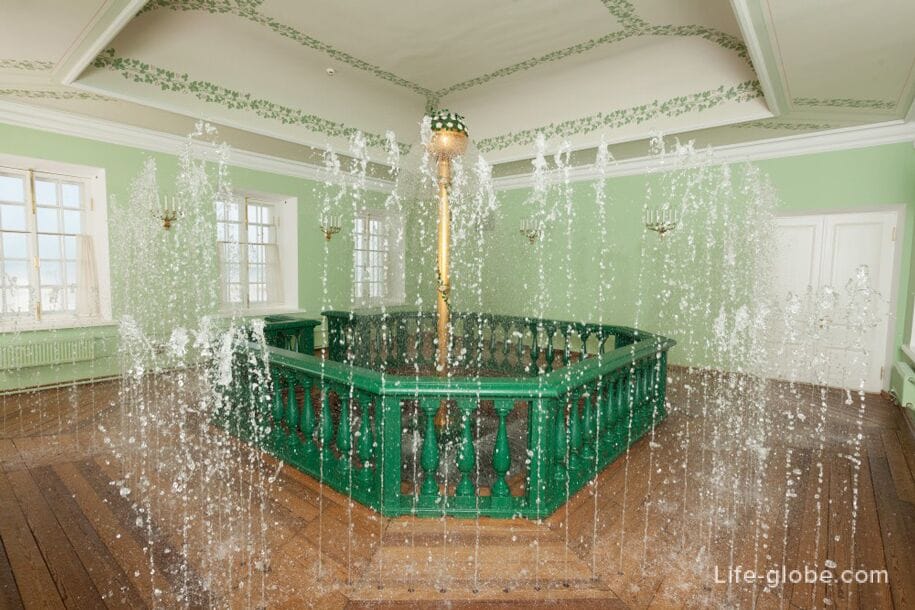
The stone building of the Bath Building was built in the second half of the 19th century for the wife of Emperor Alexander II Maria Alexandrovna. The empress, who suffered from lung diseases, took various procedures according to the fashionable system of hydrotherapy in Europe at that time.
The bath includesSteam - a traditional steam bath with a stove, where instead of stones erected a pyramid of iron nuclei; the room where the Empress took a warm bath and the bath of decoctions of medicinal herbs; Cold bath for cold water treatments, where you can see a shower disguised as a chandelier in bronze and glass, decorated with bunches of grapes and flowers of bindweed.

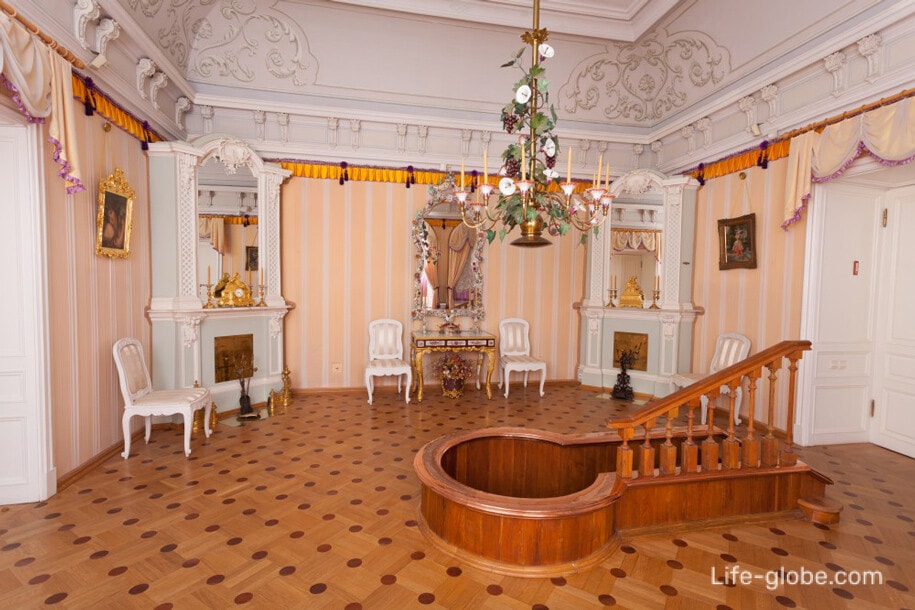
On the south side of the Bath Building is adjacent to the complex of buildings, consisting of the grand Assembly hall, Tafeldekerskaya, Kitchen and Coffee Shop.
The Assembly Hall was named in memory of the famous Peter's Assemblies, was built by the architect Rastrelli and was intended for ceremonial dinners. The walls of the hall are decorated with tapestries woven by Russian craftsmen in St. Petersburg in the first half of the 18th century and reproducing the subjects of the "Indian tapestries" received as a gift by Peter I when visiting France in 1717. The table in the hall is covered with items from the Daily service made at the Imperial Porcelain Factory in the late 18th and early 19th centuries.
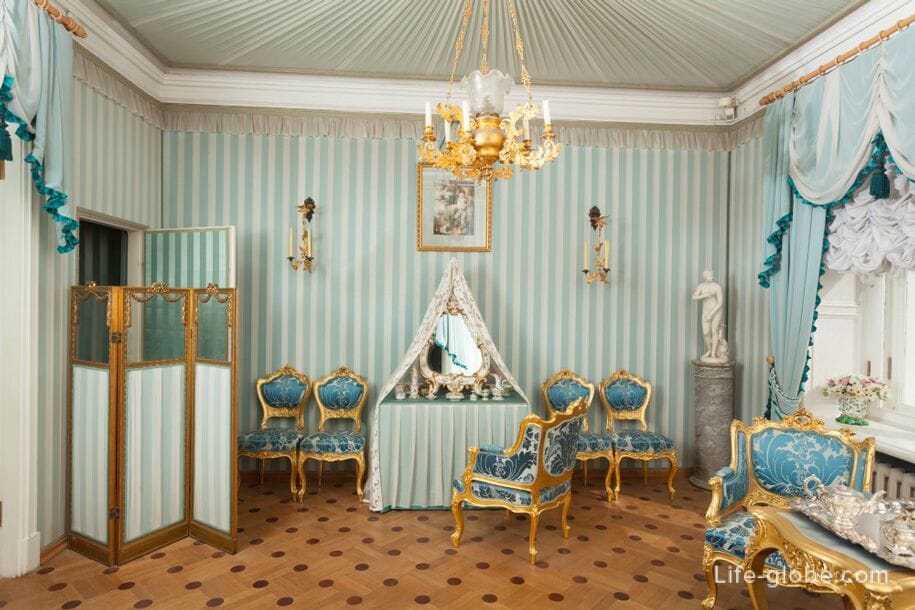
Dishes and table linen were stored in the Tafeldeker's, where the food was served through a serving window from the Kitchen, equipped with a Russian oven and stoves with exhaust tents to remove smoke. It was in this room that the chefs prepared dishes for the royal table.
In the room there are kitchen utensils of the 18th and 19th centuries, and in the neighboring Coffee Shop, where tea, coffee and hot chocolate were prepared, there is a collection of old samovars.
In the center of the listed buildings of the Montplaisir ensemble, which form something like a courtyard, there is a small Montplaisir Garden, formed according to the plan of Peter I and made on the model of regular gardens.
In the garden: fountains, alleys, flower beds, ornamental shrubs and trees.
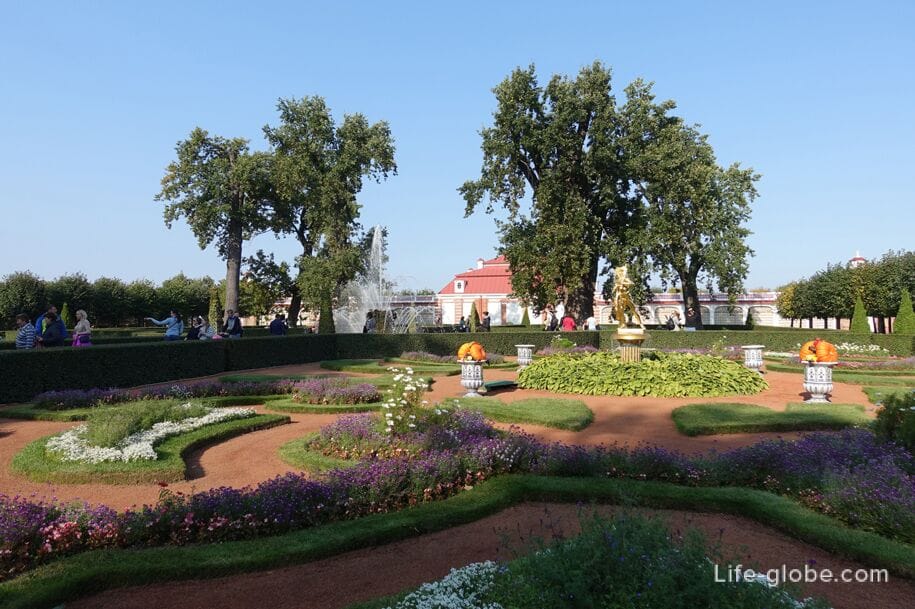

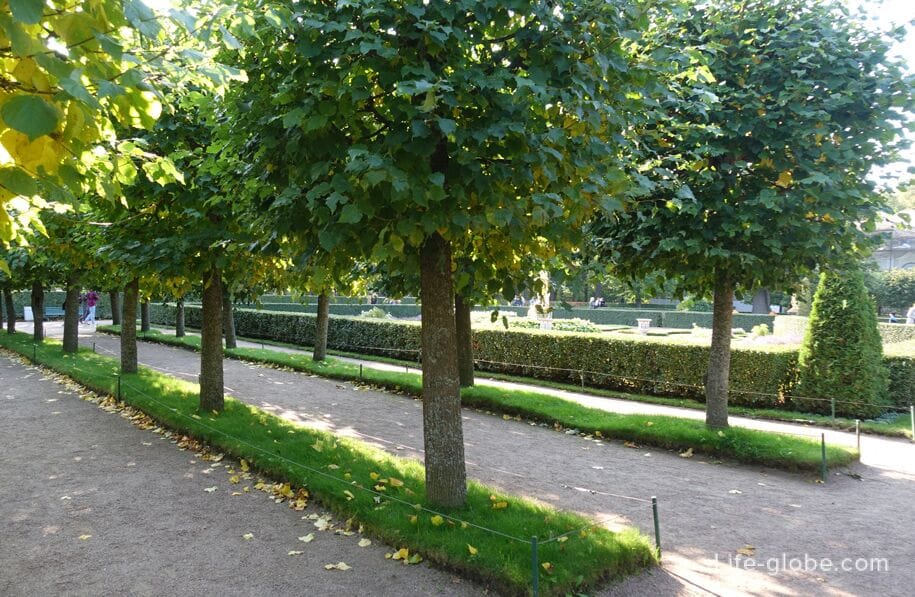
The garden is divided into four stalls, the center of each of which is decorated with a fountain " Bell». In the center of each of the four fountains there are gilded sculptures:
- the young god Apollo, called "Apollino" and representing a copy from the ancient original of the 4th century BC.;
- Psyche-a copy of the original, made by the Italian sculptor of the classical era Antonio Canova;
- "The Faun with the kid" - a copy from the ancient original of the first century BC.;
- "Bacchus" - a copy of the work of the Italian sculptor and architect of the High and Late Renaissance-Jacopo Sansovino.
The fountains were created in 1721-1723 according to the drawings of N. Michetti. The dilapidated lead statues were replaced with bronze ones in 1817.
Fountains also differ in their base. Two pedestals have the shape of a vase with relief acanthus leaves, and the other two-the shape of columns with flutes-vertical recesses, grooves on the trunk of the column.
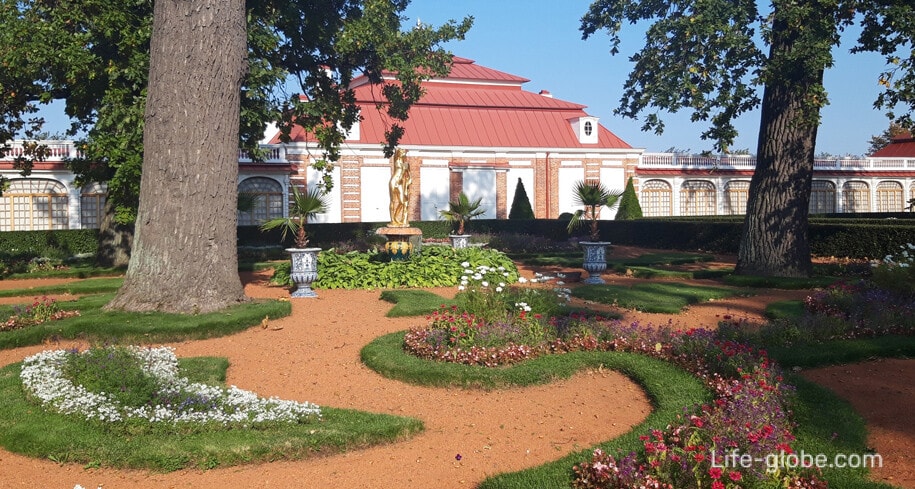

In the center of the garden, between the four parterres, there is a fountain "Sheaf".
This powerful and magnificent fountain was designed by architect N. Michetti according to the drawing of Peter the Great. The fountain was launched in 1723.
The fountain is placed in a deep pool with a diameter of 12 meters. The cordon of the fountain is carved out of Pudost stone and decorated with tuff, and the bottom of the pool is lined with black and white marble slabs. From the tuff pedestal, located in the middle of the pool, a central jet of water flows to a height of four and a half meters, around which twenty-four inclined jets, arranged in two tiers, beat. They resemble a large sheaf of heavy ears, showering transparent grains.
In Russia, the sheaf was considered a symbol of fertility and wealth, and in the language of allegories of the 18th century, this fountain became the personification of the power and prosperity of the Russian Empire.
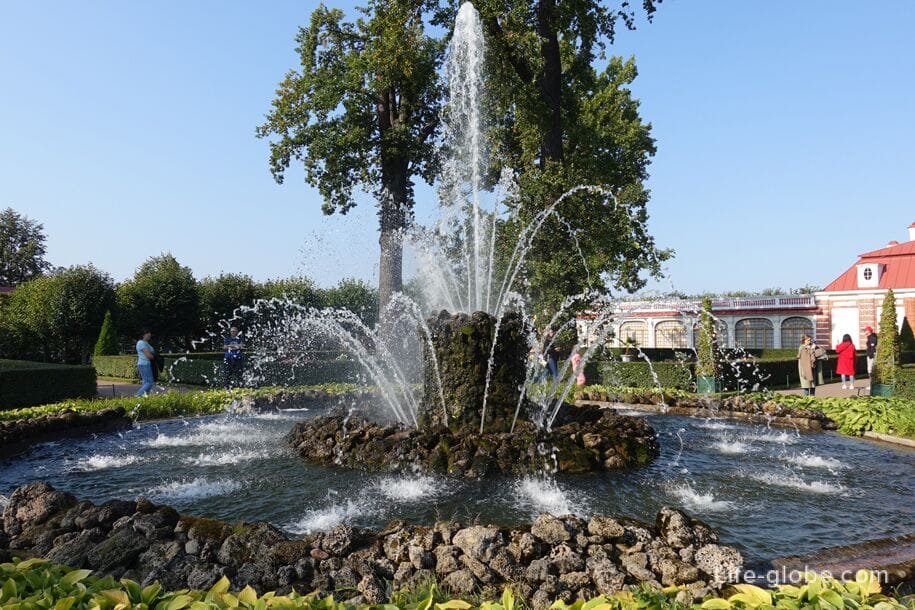
Video of the Montplaisir Garden with fountains
The southern corners of the Montplaisir garden are decorated with fountains-firecrackers "Sofas", of which there are two and which look like benches-sofas.
These are the oldest of the Lower Park firecrackersthat have survived to our time. They were created according to the drawings of N. Michetti, personally corrected by Peter I, and "tested by water" in 1723.
Since then, the appearance of the fountains has not changed.
Near the benches-sofas there are stone platforms from which water jets beat, which in imperial times were a "surprise" - water jets beat only when the guest stepped on the stone platform in front of the bench; the water poured over the magnificent outfits, which amused others. Read more about the fountains-firecrackers " Sofas»…
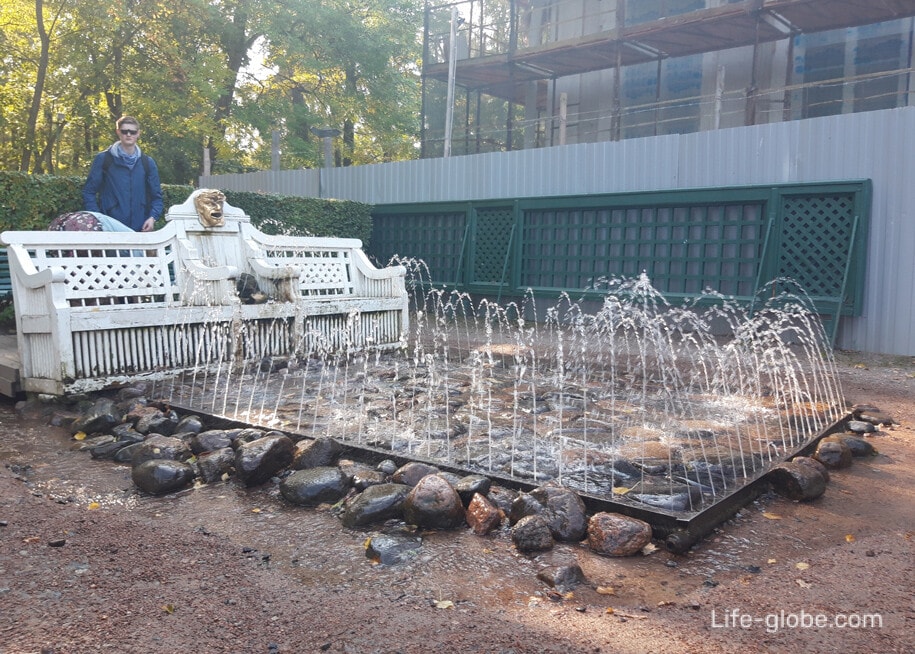
The Monplaisir Ensemble is located in the north-eastern part of the Lower Park of the Palace and Park Ensemble "Peterhof", which belongs to the State Museum-Reserve"Peterhof".
The fountains of Peterhof are closed for the winter (do not work) - from about the middle of October until the 20th of April.
In winter, when the fountains are not working, the entrance to the Lower Park is free (free of charge).
During the summer season, the fountains are open and the entrance to the park is paid.
Entrance to each of the three museums located in the buildings of the Montplaisir ensemble is paid. Museum visits are not included in the price of the entrance to the Lower Park - they are paid separately.
Museums can be closed for the winter, open only on certain days that change depending on the season (summer, winter), and also stop working under certain weather conditions.
Tickets to the park and museums can be purchased at the ticket offices located directly near the entrances to the park or in advance-online on the official website.
The opening hours of the park and museums, as well as the conditions of visiting and the cost of tickets, are recommended to check on the website of the State Museum-Reserve "Peterhof": peterhofmuseum.
You can visit Peterhof with one of the excursions
All the ways to get to Peterhof from St. Petersburg (the airport and the city center) can be found here →
Near the Palace and Park Ensemble "Peterhof" you can stop
The 4-star Novy Peterhof Hotel features a restaurant, a bar, parking, a tour desk, a spa area with an indoor pool, a gym, a steam bath, a Finnish cedar sauna and an aroma sauna.
The rooms are decorated in a modern style and feature a TV with satellite channels, free Wi-Fi, a safe, bathrobes and slippers, a hairdryer and free toiletries. Some rooms have a seating area.
The room rate can include: breakfast, breakfast + dinner or breakfast + lunch + dinner. Link to the hotel
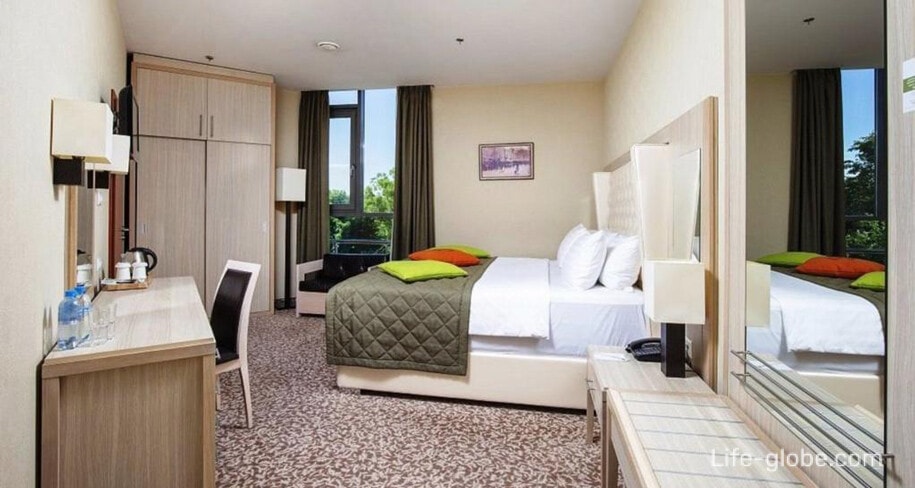
EGO-LOFT Apartment (Holgin Pond) they offer views of the lake and the city.
The apartmentfeatures air conditioning, a balcony, free Wi-Fi, a flat-screen TV, a washing machine, a bedroom, a kitchen with a dishwasher and a microwave, and a bathroom with a hairdryer and free toiletries. Link to the apartment
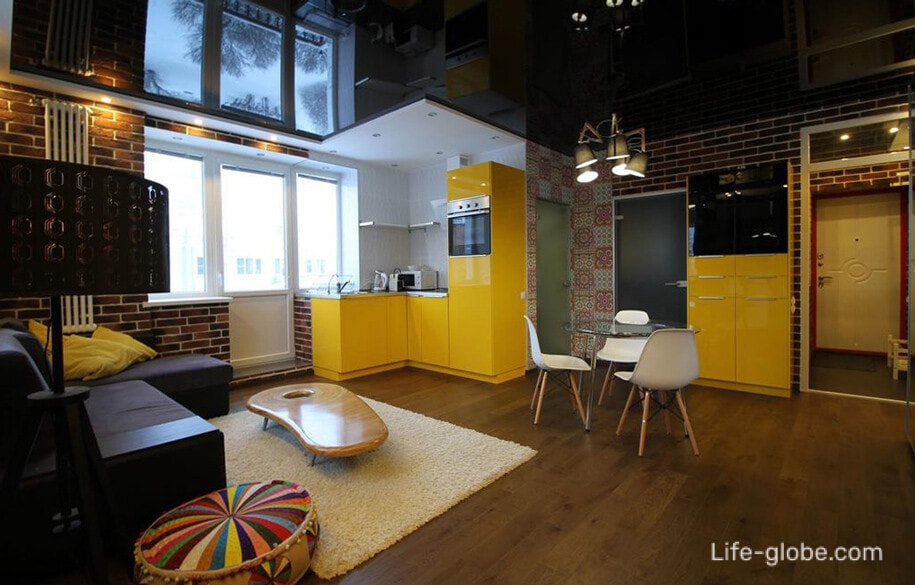
Severnaya Venezia Apartment с features a balcony with lake views, free Wi-Fi, a children's playground, a garden and a shared lounge.
The apartmentfeatures a bedroom, a flat-screen TV with cable channels, an equipped kitchen with a microwave and a refrigerator, a washing machine, and a bathroom with a shower. Link to the apartment
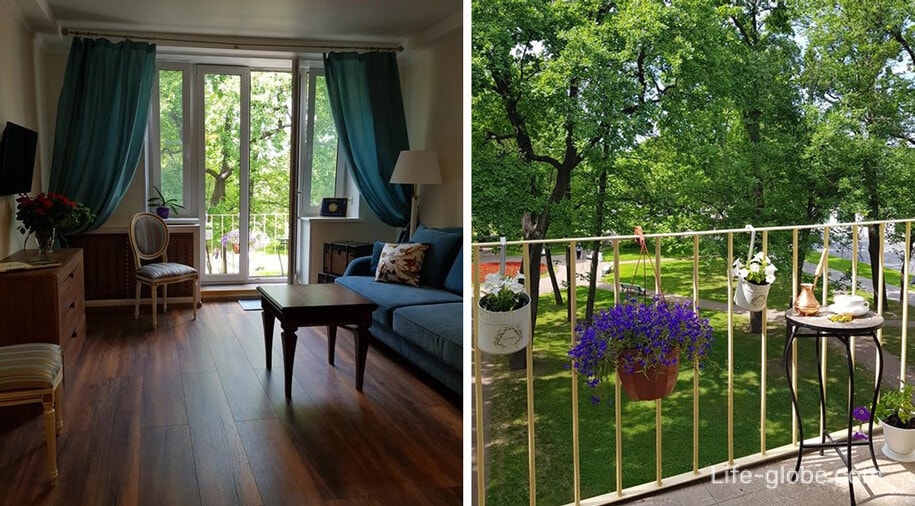
All accommodation facilities in St. Petersburg, including in the city center and in Peterhof, can be viewed and booked here